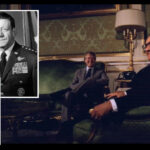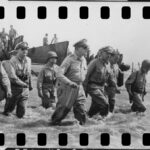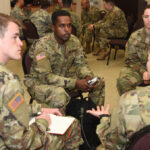
The synchronization of themes and messages to action is too often overlooked when planning strategic communication.
Strategic Communication is the lens, the filter. and the focus. It is the way and the means that gives purpose and vision to all command-led mission communications. Audiences who hear the communications but cannot discern the purpose and vision cannot make sense of why the U.S. military is doing something and how its actions connect to the words. In 2009, the Department of Defense defined strategic communication as a focused effort to understand and engage key audiences to manage conditions favorable to advancing U.S. interests, policies, and programs, using coordinated themes, messages, and products synchronized with all elements of national power. Since then the process has continued to evolve while focusing on operations in the information environment and the broader applications of communications.
The synchronization of themes and messages to action is too often overlooked when planning strategic communication. To be effective, it requires an interdisciplinary approach—with a full comms tool kit and experienced practitioners expert at applying a mix of tools including psychological operations, information operations, civil affairs, public affairs and intelligence gathering, plus enablers from other specialties.
There are robust examples of effective usage from World War II up to the present day. These operations, programs, and products are the result of multidisciplinary efforts that were effective in communicating clearly with the public and allies, demoralizing and deceiving the enemy, and in creating compliance by target audiences. They took advantage of opportunity and leveraged creativity.
The Wartime Mandate in World War II: To Deter, Demoralize, and Deceive
The challenges were enormous and the opportunities plentiful. These included the opportunity to demoralize the Japanese Army troops occupying China, to deter Nazi soldiers from the coastal areas in France where D-day landings were to take place, and to create openings for captured allied soldiers to escape enemy hands. These three examples show the ingenuity of U.S. troops and the beginnings of a multidisciplinary approach that would take several generations to mature.
The Office of Strategic Services (OSS) Morale Operations Division had the mission set of using and manipulating information to have a psychological effect on enemy forces and the enemy’s home civilian supporters as well. One example is that of former newspaper reporter, Betty McIntosh. She worked for OSS Morale Operations in India and then China. When a Japanese battalion was wiped out in combat, Betty came up with the plan to empty a dead courier’s knapsack and remove its contents: 475 soldier postcards ready to mail home to their families. Her team erased the penciled messages, replaced them with complaints about the war’s course, and voiced convictions that the Japanese were losing. They ingeniously then inserted the refilled pack into the Japanese mail system and waited for the postcards to be sent on to Japan. Her team also managed a radio station that served to mislead the Japanese.
One of the most well-known psychological operations campaigns of the war was carried out by the U.S. Army’s deception units. The “Ghost Army” famously pioneered and mastered the art of subterfuge. They created productions designed to fool the enemy into believing in a false narrative.
And they put on quite a show! One of the Ghost Army’s most notable missions, Operation Viersen, occurred in March 1945 worked to draw German units away from the section of the Rhine River where U.S. and allied troops would cross. To affect this impression, they set up inflatable tanks, ran sound machines day and night, plus set up multiple fake headquarters to mislead and to impact enemy planning.
Other wartime deception campaigns were cleverly disguised, misleading the enemy while providing information and tools to allied soldiers being held in Nazi POW camps. The delivery system was Monopoly, a popular game board in the 1940s. Leeds game maker Waddington’s was tasked by the British Secret Service to create a Monopoly board that would assist captured allied prisoners of war in planning to escape. The Germans never suspected the game boards were more than a diversion, a means of keeping prisoners occupied. They were packed with maps, money, a compass, and other tools, all carefully hidden.
These efforts to employ information operations during the war were decidedly effective, small in some cases, not part of a larger coordinated effort but definitely executed as a supporting line of effort with specific targets, forces, and within timeframes tied to specific operations.
The Post-World War II Occupation Army: To Create Compliance and Transform Beliefs
On May 8, 1945, the allies declared victory in Europe. The following day soldiers learned they were no longer part of a fighting army, they were now members of an occupying force. It was a fundamental and rapid shift. Tanks were quickly exchanged for trucks. Enemy soldiers were interrogated and processed for release or repatriation and relations with the civilian population in Germany and other Axis nations began to evolve.
Yet the battle for hearts and minds continued. By September 1945, the U.S. Army released a pamphlet, the U.S. Program for the Occupation of Germany. It served to guide the newly designated peacekeepers, listing America’s strategic aims in terms that soldiers at all levels could understand and support. These were de-Nazification of Germany, de-militarization of Germany, the payment of reparations, reeducation of the German people, restoration of democratic processes in running the government, and the rehabilitation of the German economy and the rebuilding of civilian enterprises. Of note the pamphlet makes it clear that “A free press and free radio are essential to these developments.”
A May article in Yank: The Army Weekly focused on the Army’s Psychological Warfare Division (PWD) and its role in communicating with defeated German soldiers and the German civilian populace. It featured Radio Luxembourg, the second most powerful radio station in the world prior to the war, and a significant part of the Nazi propaganda campaign during it. It fell to the Americans on Sept. 22, 1944, and was reconstituted and back on the air, only twelve days later.
“This is Radio Luxembourg,” the U.S. announcer began. “Radio Luxembourg returns to the air a free station, with programs of the United Nations.” Its reach was extensive, entering nearly every German home equipped with a Nazi-government provided “People’s Radio Receiver.” The new station provided music, news, and entertainment. The station also covered the trials and execution of German spies and let POWs make “I’m alive and a prisoner of the Americans” announcements, giving families reassurance their loved one had survived. It also provided information important to recovering communities as they struggled to rebuild. One campaign was entitled “Don’t Sabotage,” with warning messages like: “If you destroy mines and factories, you’re really destroying jobs.” This campaign made it clear that sabotage would only result in self-harm. “If you destroy power plants, you will have no lights.”
Such campaigns were in line with the primary strategic objectives of the post-war occupation force—de-Nazification and rebuilding. Radio was clearly an effective propaganda tool and its most effective weapon was the truth, often spoken by those who had surrendered or been harmed by Nazi oppression. It was essential to promoting compliance and supporting change.
In the decades following World War II the advances in mass communications and the speed of information dissemination have transformed both the uses and accesses to various types of information.
Mass Communication Advances to Present
In the decades following World War II the advances in mass communications and the speed of information dissemination have transformed both the uses and accesses to various types of information. The technology impacts of this revolution also affected information operations campaigns, making it more difficult for planners to target one specific population or group with propaganda or deception without inadvertently affecting other groups and even disinterested parties. The main sources of information available to planners originated with the military intelligence operations and programs and plans remained stovepiped, with public affairs functioning in one lane while information operations, psychological operations, and perhaps public diplomacy and others pursuing their own programs that often may not have been supportive, much less complementary. Occasionally information program lanes conflicted, creating friction in consistency of messaging. Today, the multidisciplinary approach has not only returned, but it is also becoming increasingly robust.
Given the immediacy of communications today, the 24/7 capability of news outlets and the global reach of social media plus the impacts of AI, could some of the information operations carried out during World War II be as successful today? Perhaps some could be successful, but only if conducted with an isolated population as a target. It is the application of new technologies that blur the lines for all audiences. The spread of deep fakes, social media falsehoods, manipulated images and more cause concern for the impacts on all audiences, and the follow-on effects diluting the communications efforts of public affairs and information campaigns.
In 2024, Army Cyber Command initiated efforts to manage the command’s information advantage enterprise, activating a new unit, the Theater Information Advantage Detachment (TIAD). This unit and additional TIADs are scheduled to be fully operational in FY 2026 and operational in every theater. This effort is designed to provide a strategic advantage in the strategic applications of information as our adversaries continue to demonstrate their robust and far-reaching capabilities in the information domain. U.S. allies have been similarly making strides in not only detecting disinformation but in increasing efforts to ensure a robust strategic communications effort.
The Russian government is extremely adept at strategic communication, utilizing the application of political technology. This refers to the tactics and techniques that not only attempt to influence public opinion in the political realm, but to continue to sow division throughout U.S. culture and society, with the goal of undermining democratic institutions. Political technology uses tools similar to those that were so very effective in the Second World War but with the addition of high-tech delivery platforms they are even more comprehensive and destructive. Social media, blogs, slanted news outlets and others blanket the media space with sophisticated propaganda, disinformation and deceptive stories and images, false video clips and more. Troll farms and the process of information laundering are increasingly sophisticated and persistent in prying apart the very fabric of society, leaving only threads behind.
There are numerous examples of information laundering related to the Russian invasion of Ukraine. These typically involve a false story that is repeated by a cascading number of other sources until the origin is obscured, and the increasing number of related stories grant the original more legitimacy. One such example is that of a Russian state media story stating that the U.S. would use infected birds as part of a biological warfare campaign. The story was repeated until the end result was confusion about what was real and what wasn’t. According to political theorist Hannah Arendt, “Constant lying, if unchecked, necessarily overthrows every standard of value…the result is not that you believe the lie, but that no one believes anything anymore.”
As Colonel Michael J. Kelley argues in his paper, “Understanding Russian Disinformation and How the Joint Force Can Address It,” the joint force must become proficient in applying new information doctrine and countering disinformation and the effects of political technology. Other nations, and NATO are increasingly effective in countering Russian efforts.
Chinese disinformation has likewise reached new heights. There is ongoing targeting of U.S. citizens, businesses and news media in a concentrated effort to repress any criticism of the Chinese Communist Party, or support for Taiwan. These attacks, often overwhelming in volume and vitriol, are often personal and threatening. Indo-Pacific Information warfare will continue and it is through the efforts of prevention, awareness and preparation through the U.S. and its allies to heighten awareness, expose disinformation and counter AI-driven campaigns.
It appears that principles of strategic communication are coming into focus both from the DoD standpoint and from the operational application of those principles by our allies. What was once referred to as a ”battle for hearts and minds” is rapidly transforming into the goal of “delivering strategic success in the cognitive dimension during peacetime.” But the key principle remains that strategic communication only succeeds when the target audiences perceive our operational purposes and vision as we intend. They must know why our military is conducting operations and how it will accomplish its mission, and that necessitates multidisciplinary approaches that reinforce the intended themes and message at every turn. When it comes to strategic communication, the means may have evolved but the principles of its success have not.
Mari Eder is a Featured Contributor to WAR ROOM. She is a retired major general in the U.S. Army and an expert in public relations and strategic communication.
The views expressed in this article are those of the author and do not necessarily reflect those of the U.S. Army War College, the U.S. Army, or the Department of Defense.
Photo Description: One of the inflatable M8 Greyhound armored cars stationed near Plabennec, used as a decoy by American forces.
Photo Credit: National Archives





What an amazing and incredible analysis and crystalization of the importance of communication in our lives. The concepts illuminated here are certainly applicable and essential for efficient and effective functioning at every level.
Here is the concluding paragraph of our article above:
It appears that principles of strategic communication are coming into focus both from the DoD standpoint and from the operational application of those principles by our allies. What was once referred to as a ”battle for hearts and minds” is rapidly transforming into the goal of “delivering strategic success in the cognitive dimension during peacetime.” But the key principle remains that strategic communication only succeeds when the target audiences perceive our operational purposes and vision as we intend. They must know why our military is conducting operations and how it will accomplish its mission, and that necessitates multidisciplinary approaches that reinforce the intended themes and message at every turn. When it comes to strategic communication, the means may have evolved but the principles of its success have not.”
Questions:
a. What is our political objective today?
b. What is our strategy today, and how is it designed to help us achieve this such political objective?
c. Based on the answers given my “a” and “b” above, what is the definition of — and some examples of — what “strategic success” would look like today? And:
d. Can someone tell us, and/or show us, exactly (a) how our current “strategic communications” efforts are being designed and implemented; this, (b) to deliver such specific “strategic success” into our hands?